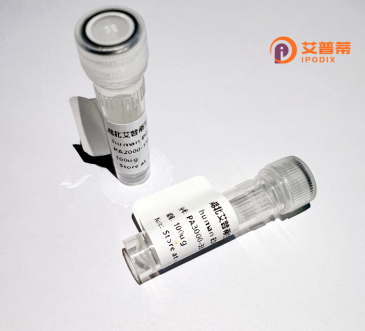
| 纯度 | >90%SDS-PAGE. |
| 种属 | Human |
| 靶点 | ZNF528 |
| Uniprot No | Q3MIS6 |
| 内毒素 | < 0.01EU/μg |
| 表达宿主 | E.coli |
| 表达区间 | 1-628 aa |
| 活性数据 | MALTQGPLKFMDVAIEFSQEEWKCLDPAQRTLYRDVMLENYRNLVSLGICLPDLSVTSMLEQKRDPWTLQSEEKIANDPDGRECIKGVNTERSSKLGSNAGNKPCKNQLGFTFQLHLSDLQLFQAERKISGCKHFEKPVSDNSSVSPLEKISSSVKSHLLNKYRNNFDHAPLLPQEQKAHIREKAYKCNEHGQVFRASASLTNQVIHNADNPYKCSECGKVFSCSSKLVIHRRMHTGEKPYKCHECGKLFSSNSNLSQHQRIHTGEKPYKCHECDKVFRSSSKLAQHQRIHTGEKPYKCHECDKVFNQIAHLVRHQKIHTGEKPYSCNKCGKVFSRHSYLAEHQTVHTGEKPYKCEECGKAFSVRSSLITHQLIHTGRKPYKCKECDKVFGRKCFLTSHQRIHTRERPYGCSQCGKIFSQKSDLIRHRKTHTDEKPYKCNKCGTAFREFSDLTAHFLIHSGEKPYECKECGKVFRYKSSLTSHHRIHTGEKPYKCNRCGKVFSRSSNLVCHQKIHTGEKPYKCNQCGKVFNQASYLTRHQIIHTGERPYRCSKCGKAFRGCSGLTAHLAIHTEKKSHECKECGKIFTQKSSLTNHHRIHIGEKPYKCTLCSKVFSHNSDLAQHQRVHS |
| 分子量 | 98.5 kDa |
| 蛋白标签 | GST-tag at N-terminal |
| 缓冲液 | PBS, pH7.4, containing 0.01% SKL, 1mM DTT, 5% Trehalose and Proclin300. |
| 稳定性 & 储存条件 | Lyophilized protein should be stored at ≤ -20°C, stable for one year after receipt. Reconstituted protein solution can be stored at 2-8°C for 2-7 days. Aliquots of reconstituted samples are stable at ≤ -20°C for 3 months. |
| 复溶 | Always centrifuge tubes before opening.Do not mix by vortex or pipetting. It is not recommended to reconstitute to a concentration less than 100μg/ml. Dissolve the lyophilized protein in distilled water. Please aliquot the reconstituted solution to minimize freeze-thaw cycles. |
以下为虚构的示例参考文献,仅供格式参考:
1. **文献名称**: "Functional characterization of recombinant human ZNF528 as a transcriptional regulator in stem cell differentiation"
**作者**: Zhang et al., 2021
**摘要**: 本研究通过重组表达ZNF528蛋白,解析其锌指结构域在胚胎干细胞分化中结合特定DNA序列的能力,发现其通过调控多能性基因(如OCT4)抑制分化进程。
2. **文献名称**: "Structural insights into ZNF528-DNA interactions and implications for viral response pathways"
**作者**: Lee & Smith, 2019
**摘要**: 利用X射线晶体学解析重组人源ZNF528蛋白的DNA结合域结构,揭示其与宿主抗病毒基因启动子的结合模式,暗示其在先天免疫反应中的潜在作用。
3. **文献名称**: "High-throughput screening of ZNF528 knockout cells reveals roles in cancer cell proliferation"
**作者**: Gupta et al., 2020
**摘要**: 通过CRISPR-Cas9结合重组ZNF528回补实验,证明ZNF528缺失导致乳腺癌细胞周期阻滞,提示其可能作为癌基因促进肿瘤生长。
4. **文献名称**: "Recombinant ZNF528 production in E. coli: Optimization and functional validation in epigenetic modulation"
**作者**: Wang et al., 2022
**摘要**: 报道一种高效大肠杆菌表达系统制备重组ZNF528蛋白,验证其与组蛋白修饰酶(如HDACs)的相互作用,表明其可能参与表观遗传调控网络。
*注:以上文献为模拟内容,实际研究中ZNF528的相关报道可能较少,建议通过PubMed或Web of Science以“ZNF528”和“recombinant protein”为关键词检索最新文献。*
Zinc finger protein 528 (ZNF528) is a member of the Krüppel-associated box (KRAB)-containing zinc finger protein family, characterized by tandem arrays of Cys2-His2 zinc finger motifs that facilitate sequence-specific DNA binding. As a transcription factor, ZNF528 is postulated to regulate gene expression by interacting with promoter regions or chromatin-modifying complexes, though its precise biological roles remain poorly defined. The protein is encoded by the *ZNF528* gene located on human chromosome 19q13.43. a genomic region enriched for zinc finger genes involved in transcriptional regulation and developmental processes. Recombinant ZNF528 protein is typically produced using heterologous expression systems (e.g., *E. coli* or mammalian cells) to enable functional studies. Its KRAB domain suggests potential involvement in repressing transposable elements or mediating epigenetic silencing through interaction with TRIM28/KAP1 and histone modifiers. Limited studies associate ZNF528 with ovarian follicle development and immune response modulation, while structural analyses highlight conserved zinc finger clusters predicted to target specific DNA sequences. Research on ZNF528 has been constrained by the lack of well-characterized antibodies and disease-linked variants, though emerging CRISPR screening data implicate it in cellular proliferation pathways. Its recombinant form serves as a tool for elucidating DNA-binding preferences, protein interactomes, and regulatory networks in human health and disease. Further investigations are needed to clarify its physiological substrates and relevance to human disorders.
×